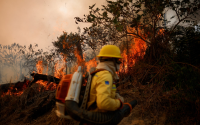Common Dreams / Published on Monday, July 7, 2008 by ReutersLaura MacInnis
Food safety experts agreed for the first time on the qualities defining a tomato, in a first step toward an international code on preventing fruit and vegetable contamination.
Tomatoes are currently the focus of an investigation by U.S. health officials who are looking for the cause of a salmonella outbreak that has sickened 922 people in at least 40 states.
World Health Organization (WHO) scientist Peter Ben Embarek said the classification of tomatoes based on their size, shape, color, firmness, and defects, and accordant rules on tomato labeling, would facilitate trade and eventually make it easier for regulators to impose safety standards.
"Now it is much clearer for everybody what you call a Class 1 tomato, for example, and what you can expect when you buy a Class 1 tomato," Ben Embarek said at the end of a week-long meeting of the Codex Alimentarius Commission, a food safety body.
"It is part of an effort of Codex to improve the quality and safety of fruit and vegetables," he said, adding that officials planned to later focus on leafy green vegetables and melons.
"Within a few years you will have safety standards for all these products, looking at where the contamination comes from," he said, describing risks from soil, water, and wild animals that can result in health problems for consumers.
The Codex Alimentarius, or food code, is a global reference point for producers, processors, regulators and traders.
Its limits for toxins, bacteria and other compounds in foods are used by the World Trade Organization (WTO) as the public health benchmarks countries should be allowed to enforce with import rules. Measures requiring more stringent standards are considered unfair barriers that can be challenged in WTO court.
The 124 countries participating in this week's Codex meeting in Geneva also agreed to new standards on the safe harvesting, processing and transportation of oysters and other molluscs, including allowable levels of toxins and how to test for them.
"It is a whole set of recommendations that will ensure the safety and quality of live molluscs. It allows us to produce these animals using a much safer process than we had in the past," Embarek said, noting the best-practices should help avoid having people fall ill from eating the seafood.
Some specific hygiene issues, such as the level of chlorine that can be allowed in water used to clean the animals, were referred to a Codex sub-committee for review before they are formally agreed to, the WHO expert said.
Earlier in the week, the Codex meeting also set hygienic standards for the preparation of powdered formula, set maximums for natural toxins found in nuts, and specified the conditions in which foods can be called gluten-free.
One issue — the amount of an animal-feed additive allowed to be given to pigs whose meat is sold as pork — was deferred for consideration next year. China and the European Union both wanted the additive limited under Codex standards, while other countries thought it should not be, officials said.






